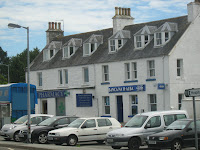 Having arrived at Sabhal Mor Ostaig by bus on Tuesday 23 June 2009, I set about orienting myself to the location. I have to say that this part of the trip was the culmination of at least 3 years of dreaming.
Having arrived at Sabhal Mor Ostaig by bus on Tuesday 23 June 2009, I set about orienting myself to the location. I have to say that this part of the trip was the culmination of at least 3 years of dreaming.Sabhal Mor Ostaig, which means the Red Barn of Ostaig, was established in 1973 by Ian Noble, a Glaswegian philanthropist, who bought the land surrounding the college from the then Laird of Clan Macdonald. The story goes that, when the manager was showing Noble around the grounds, he had pointed to some dilapidated stone farm buildings and said, "And that is where the university will be." Of course, every one thought he was barmy but nevertheless, it was not long after that the college was established in the very buildings Noble had indicated. The aim was the economic development of the region, which was suffering from a lack of employment and population decline associated with urban draft. Sabhal Mor has developed into an internationally recognised National Centre for the Gaelic language and culture, and plays a leading role in the promotion of the Gaelic arts.
The conference I attended at Sabhal Mor was entitled A'Cleachdhadh na Gaidhlig: slatan-tomhais ann an dion canain sa choimhearsnachd - Using Gaelic: criteria in language maintenance in the community which ran from 23 to 26 June 2009. Presenters were asked to provide papers relating to the following:
- Language in the home, the family and the community;
- Language in the workplace, public organisations and clubs; or
- Language in education in the primary to tertiary and life-long learning sectors.

My paper was entitled 'Te reo i te kāinga - revitalising language in the home: national language strategies in Aotearoa New Zealand and Alba Scotland". The focus of my paper was the national language plans for Māori and Gaelic and how much emphasis was being put on reviving the language in the home. My key finding was that, although the national plan for Gaelic is a far more comprehensive strategy overall, its focus on Gaelic in the home revolves around promoting language status, rather than the other areas of language planning, namely, language usage, language acquisition and language corpus.
The conference itself was amazing; it allowed me to have a primary experience of the situatuion surrounding Gaelic language revitalisation in Alba Scotland. It also enabled me to build and further develop my research connections in that place. The biggest challenge of the conference was that over half of the conference papers were presented in Gaelic as opposed to English. As a non-Gaelic speaker, this was a real challenge. However, I was happy to stand back and listen as this is part of language revival in practice and I commend them for it.
 I presented my conference paper on Saturday 25 June to a full house of about 30 people; it was probably the best attendance of the week, from what I saw. I think that being from Aotearoa was a huge draw card in that respect, as we have a reputation for being one of the leaders in Indigenous language revival. The paper was well received and has enabled me further build my research networks.
I presented my conference paper on Saturday 25 June to a full house of about 30 people; it was probably the best attendance of the week, from what I saw. I think that being from Aotearoa was a huge draw card in that respect, as we have a reputation for being one of the leaders in Indigenous language revival. The paper was well received and has enabled me further build my research networks.
Big thanks go out to the people who supported my attendance at the Using Gaelic conference: University of Otago's Division of Humanities; Ngā Pae o te Māramatanga's Knowledge Exchange; and Otago Polytechnic. Ngā mihi nunui ki a koutou! The conference and travel to Scotland have been invaluable for my PhD research; this experience has enabled me to move the thesis forward through the knowledge I have gained and the connections I have made whilst attending the conference.











